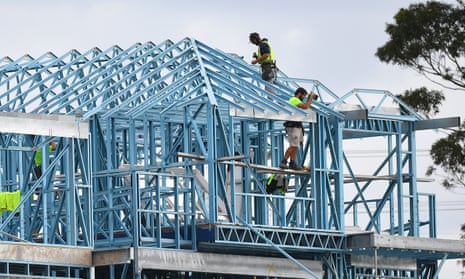Australia should launch an ambitious program to build public housing for 30,000 families and individuals to boost the post-crisis economic recovery and reduce homelessness, the Australian Council of Social Service has said.
While business has renewed its calls for more flexible workplace relations laws and corporate tax cuts on the other side of the Covid-19 crisis, Acoss is warning against any sudden “snap back” to old economic and social policies, saying it could harm the recovery.
In a new plan to “build back better”, the advocacy group has called for ongoing support to be provided to low- and modest-income households, noting they are most likely to spend it, while avoiding any return to the “brutality” of $40 a day in unemployment payments.
One of the key planks of the plan is a $7bn scheme to build 30,000 social housing dwellings.
In its report, released on Wednesday, Acoss said the Covid-19 lockdowns had “exposed the scale of homelessness and rough sleeping in Australia, both as a social problem and as a health risk”.
Even with winter approaching, services had been struggling to find suitable accommodation for people while maintaining physical distancing measures.
The chief executive of Acoss, Dr Cassandra Goldie, said there was a lot of talk about fast-tracking infrastructure projects to spur the economic recovery.
“We say we should pick the kind of builds that will deliver jobs and deliver them relatively quickly,” she said.
Goldie said housing construction should be rolled out “as rapidly as possible” in partnership with states and territories and targeted to areas of need all around the country.
The last census found more than 116,000 people were sleeping rough or in overcrowded or insecure accommodation – about 50 out of every 10,000 people.
As part of the response to the global financial crisis, the Rudd and Gillard governments spent $5.6bn over three and a half years on a social housing initiative. A report by KPMG found that for every $1 invested in construction activity, about $1.30 in economic turnover was generated.
But after the GFC, Goldie said, successive governments “just cut away with this obsession of trying to return a budget to surplus at the expense of people who really got left behind back then, and we don’t want that to happen this time around”.
In addition to social housing, Acoss called for a national program to improve energy efficiency and install solar panels on the homes of people on low incomes.
Other elements of the five-point plan are: increasing income support to people most in need; closing the gaps in home care services to focus on those most at risk and create jobs; and pursuing reforms to avert a rise in long-term and structural unemployment.
There is growing political support for a longer-term increase in unemployment benefits as the coronavirus supplement that effectively doubles the jobseeker payment is due to expire in six months.
The former deputy prime minister Barnaby Joyce told Guardian Australia on Tuesday: “There will always be some who exploit any system but that can not be the reason we hurt the bona fide unemployed.”
